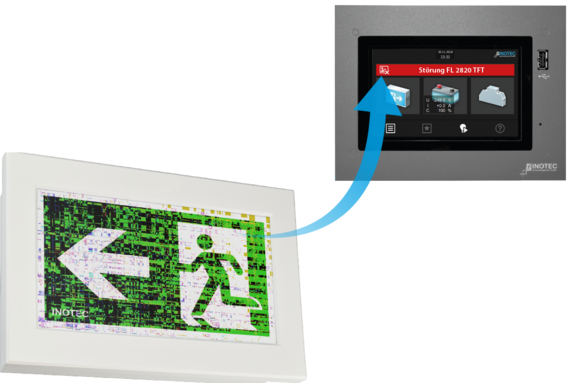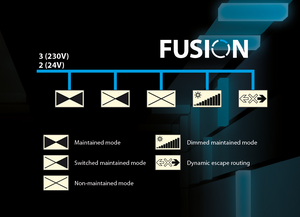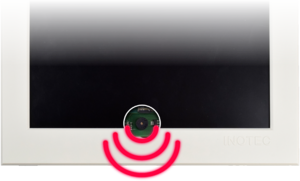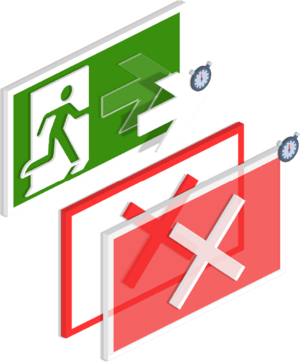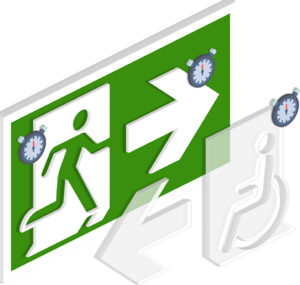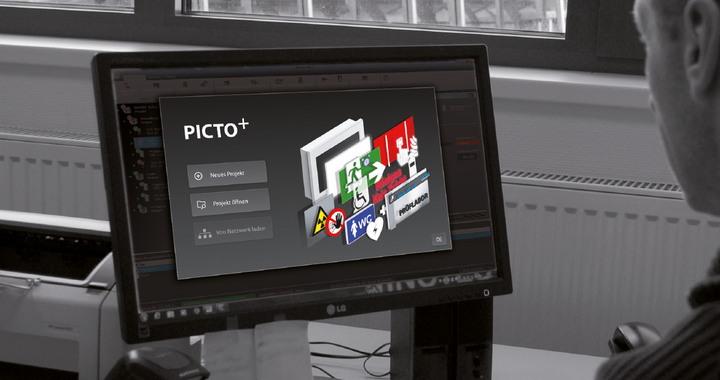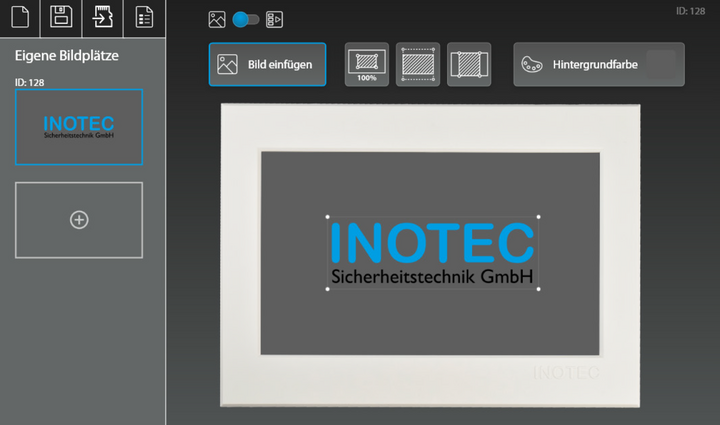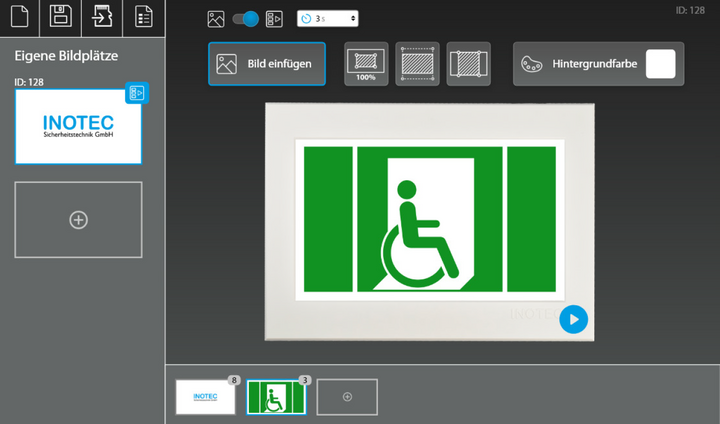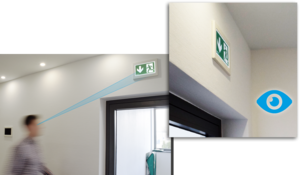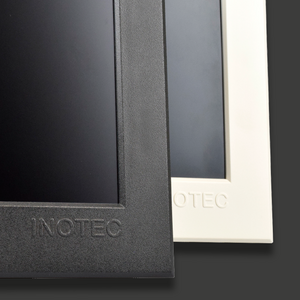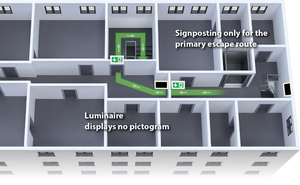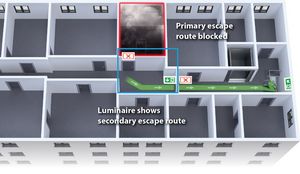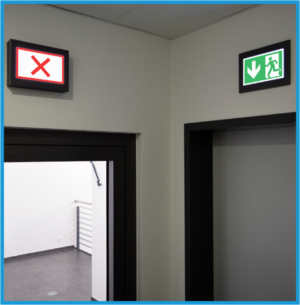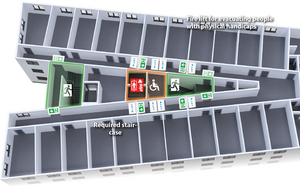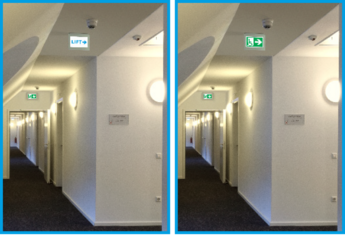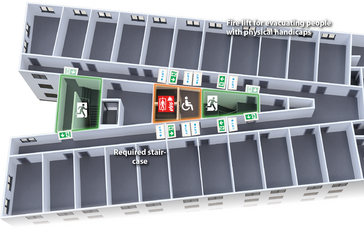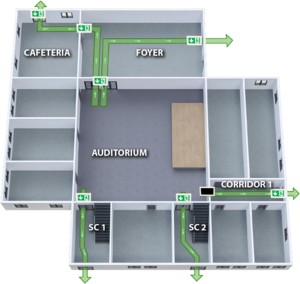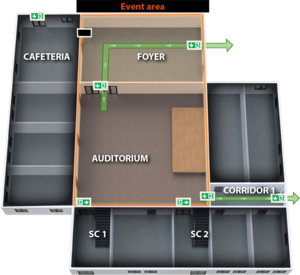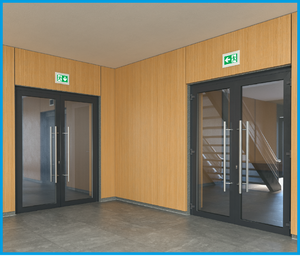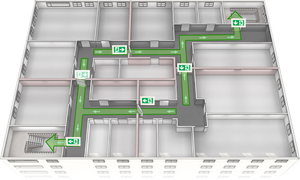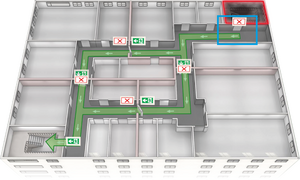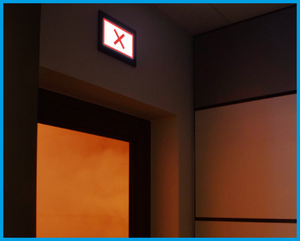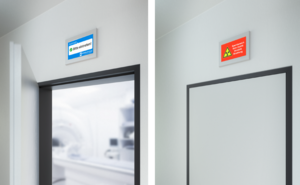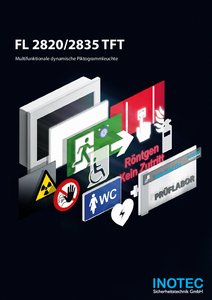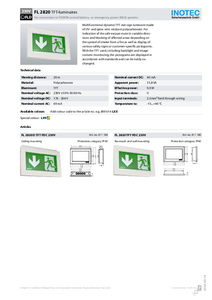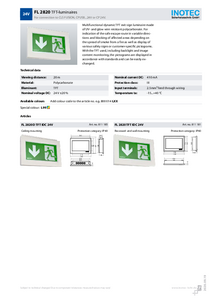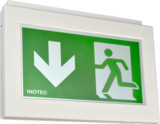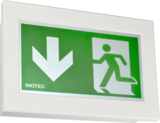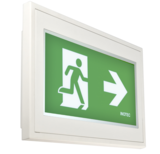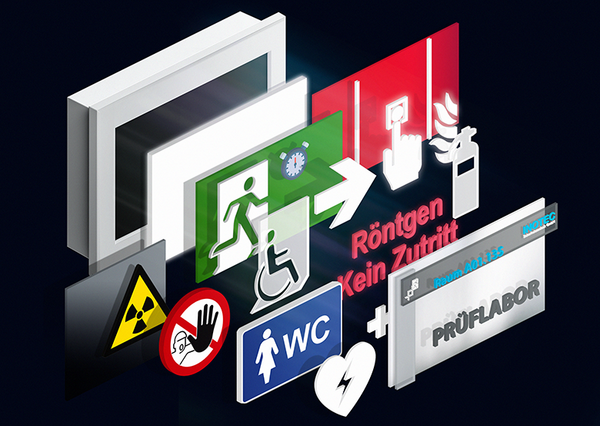
FL 2820 TFT
Multifunctional dynamic pictogram luminaire
Dynamic, standard-compliant and with user-definable pictograms
These features are just a few of the highlights of the new generation of luminaires. With its TFT display, the FL 2820 TFT offers the possibility of displaying a wide variety of pictograms, images or even animations. Accordingly, dynamic escape routing with fully standard-compliant pictograms is now possible for the first time ever.
Convincingly innovative - the FL 2820 TFT lamp is the "Product of the Year 2020
Their innovative features convinced the jury of the "FeuerTrutz Award".
Read here why the multifunctional dynamic pictogram light is rightly called "Product of the Year 2020".
Flexible pictograms – even in accordance with customer requirements
Thanks to the TFT technology used, a wide variety of pictograms can be displayed. The common emergency escape, first aid and fire safety signs can be selected from a library or your own pictogram specifications can be implemented using free software.
For example, the luminaires can indicate an alternative escape route or support the primary escape route with direction signs in an emergency and signpost meeting rooms. Subsequent adjustments to the pictograms arising from changes in standards or usage are possible at any time inexpensively and without having to change them mechanically.
Monitoring
As with all INOTEC luminaires, the FL 2820 monitors all functions as standard. For example, in addition to the LED backlight, this luminaire also monitors the image output of the TFT display. A report is sent to the FUSION system immediately if the pictogram and specification are inconsistent. This permanent image monitoring – developed and patented by INOTEC – is unique and represents a novelty in safety lighting.
The following errors are detected by the luminaire and reported to the FUSION system:
| Backlight error The LEDs used in INOTEC emergency exit luminaires are always monitored to ensure the luminance and homogeneity required by the standards. This is also achieved by monitoring the TFT backlight on the FL 2820 TFT. | Image monitoring sensor error |
Communication errors | Incorrect or faulty pictogram |
| SD card error Custom pictograms are stored on an SD card in the luminaire. If an error is detected, an error message is sent to the FUSION system. |
Bidirectional communication – without additional bus line
Connected to the CPS FUSION system, the FL 2820 TFT communicates bi-directionally with the central battery system. If a change of direction of the arrow or the blocking of a smoky escape route by the central battery system is specified, the luminaire confirms the new pictogram. The re-routing is thus checked, which ensures maximum safety. Thanks to FUSION technology, communication takes place via the 230V or 24V final circuit. An additional bus line is not required.
Audible signalling device
If a fire or power failure is detected in a building, then an audible signalling device in the luminaire can be enabled by programming a switching assignment. This increases the attention of people in the building. In particular, visually impaired people are made aware of the incident.
Flashing and blocking with maximum attention
Only the directional arrow or red cross flashes when a pictogram with flashing function is needed; the emergency escape or first aid sign (or pictogram’s background) remains switched on. The flashing function raises attention significantly, the pictogram displayed remains visible at all times.
Similar to a blocked lane on a motorway or in a tunnel, the sign for blocking an escape route visually is displayed without an emergency escape or first aid sign by default. The generally known red cross is also located above the blocked area.
Animations – one luminaire for multiple pictograms
In addition to the standard safety sign, other pictograms, e.g. for wheelchair users, are more and more frequently required. Instead of using special solutions with two-part pictograms, which reduce the viewing distance, or even using two luminaires, the FL2820 TFT offers an elegant solution with an animation. The required pictograms are displayed one after the other. The selection of the pictograms and the desired display duration can be configured in the INOTEC Picto+ software. This means that it is also possible to change or sequence images from standardised pictograms and your own texts. As a result, for example, the reason for an evacuation (conceivable in the case of amok or terror) can be displayed as text alternating with a pictogram.
Create your own image content easily with PICTO+
If you need to display your own content with the FL 2820 TFT, it can be configured using the INOTEC PICTO+ software and assigned to one of the 128 possible image storage locations. A single image or an image sequence consisting of up to eight images can be stored in one image storage location. This allows the implementation of pictogram sequences with a variety of emergency escape or first aid signs (wheelchair user left/emergency exit right), for example.
Once the required luminaire configuration has been completed, it can be saved as a project and stored on the luminaire via the network or an SD card. By programming the FUSION emergency lighting system, the desired images/pictograms can now be displayed.
Perfect pictograms – from every angle
Until now, the implementation of dynamic pictograms always meant reductions in recognisability. Thanks to the TFT display used, these deficits no longer exist. The pictograms have a luminance of 800cd/m². Compared to conventional displays, the display of the FL 2820 TFT remains clearly visible even at a very sharp viewing angle.
Full compliance with standards

In addition to excellent recognisability, the TFT display can show all pictograms in full compliance with standards. This means that pictograms with arrows pointing in the opposite direction to the escaping man on the sign are now a thing of the past. In addition, the pictograms are not affected by blocking symbols which are placed in front of them and which become visible through edge irradiation and have no gaps or light edges of the kind which occur with many commercially available luminaires.
INOTEC quality – for long service life
Special colours – customisable for your project
Thanks to our own production facility in Ense, Germany, we can respond to customer requests at any time. This allows the FL 2820 TFT to be colour-matched to the requirements of the project. Due to the individual housing colour, the luminaires can be perfectly integrated into a building project, as required e.g. for conservation reasons. Thanks to the black TFT display, a luminaire with a deep black housing (RAL 9005) is almost invisible when switched off - except when it matters.
Applications
Signposting for an alternative (second) escape route
In many cases, it is necessary to mark a second escape route that should not be marked as such initially. The luminaire is hugely advantageous here because the required pictograms only become visible when activated via the FUSION technology. This selling point is absolutely unique, as at least one additional switched-off pictogram is visible on every other luminaire available on the market, which can confuse the people escaping. The TFT display is black when no pictogram is active on the FL 2820 TFT, meaning any confusion is precluded.
The sample project involves a four-storey museum building. The access route runs through the central staircase in the middle of the building. The escape route from all parts of the building normally leads outside via the central staircase. According to the evacuation concept for the building, the secondary escape route via the open staircase on the building’s right-hand side shall only be marked if the main staircase is no longer usable due to a potential build-up of smoke.
Fig. 1 shows how the escape route is normally marked. All escape signage points in the direction of the central staircase. All luminaires intended to indicate the use of the secondary escape route are switched off. There is no marking visible on this route to begin with.
Fig. 2 shows a build-up of smoke in the main staircase. Both the escape door to the main staircase and the escape door from the right-hand side of the building toward the main staircase now display a red cross to indicate they are no longer in use, thus blocking the escape route via the main staircase visually. The previously invisible escape signage that leads toward the secondary staircase now becomes active. Unambiguous escape signage indicates which escape route is safe to use depending on the situation – there is no confusion.
Emergency exits and escape routes for people with physical handicaps
More and more attention is being given to the needs of people with physical handicaps via the legal requirements for new developments and conversions.
To enable these people, to leave buildings safely, it is important to specifically mark accessible emergency exits and escape routes, as well as routes to special facilities like collection points or evacuation lifts. A flashing function in addition to the standard compliant display of the required emergency exit signs can increase attention to the signage if the general power supply fails.
The sample project shows a hotel. Only the emergency exits and escape routes leading toward the two required staircases are normally marked. The two lifts are signposted using TFT luminaires. They are positioned at the fire doors in the corridors and at the lift entrances, meaning they are visible to hotel guests throughout the floor.
The escape routes in this building are not the same for people with physical handicaps as for those without. This means that it is especially important to clearly mark the escape routes for each user group. In the event of an evacuation due to fire, the lift signs are replaced by escape route marking for people with physical handicaps. In our example, this meets two requirements simultaneously. One is the need to clearly mark the emergency exit and escape route for people with physical handicaps. The second is that by eliminating the signage on the lift, people without handicaps will not be directed to the lifts.
Change of use in a building (e.g. school with auditorium)
In many buildings, temporary changes in use can result in a different escape route situation.
The sample project shows the part of a school on the ground floor. The audiorium is located centrally and used as a recreation area and for access to classrooms and staircases during school hours. Staircases 1 and 2 are marked as escape routes during school hours and lead outside. Other escape routes lead outside via the cafeteria and foyer.
The auditorium with its stage can be used for events outside school hours. At the same time, visitors should be prevented from gaining unauthorised access to the classrooms on the upper floors via staircases 1 and 2, as well as to the cafeteria. To this end, the corresponding areas are closed off, which means there is a fundamental change in the escape route scenario.
The necessary adaptation of the escape route marking can be easily done by the TFT luminaire. This means that staircases 1 and 2 as well as access to the cafeteria can be visually blocked from a central location or made unrecognisable by switching off the luminaires. The path through corridor 1, which is not intended for normal operation, is displayed as an additional escape route. Alternatively, the luminaires above the entrances to staircases 1 and 2 could also display the alternative escape direction to corridor 1 instead of the red cross. This is freely programmable and does not require any additional planning, ordering or installation work.
Dynamic escape routing (also as a compensatory measure)
The FL 2820 TFT provides the option of a dynamic use of escape signs. Connected to the CPS FUSION or the CLS FUSION emergency lighting system, which are linked to the fire alarm system installed in the building, the luminaires can indicate the safe escape route with a standard-compliant pictogram or block smoked-filled areas.
The sample shows an office building divided into four fire (or smoke) compartments on the various floors. Staircases are located at the top right and bottom left of the building, which should enable evacuation of the floor. The shortest escape route from each compartment is signposted.
If the escape staircase or the escape route is blocked by smoke in the following section, a rerouting is made to the second staircase. All emergency escape or first aid sign luminaires that previously marked the escape route leading toward the affected staircase now display a red cross to indicate it is no longer in use, thus blocking the route leading toward the fire. As a result, escaping persons are guided into the right direction by a safe escape route out of the building.
Room signage
Thanks to its outstanding flexibility, the FL 2820 TFT can be used not only for static or dynamic escape route marking but also for room signage.
The application example shows how access control can be implemented with the TFT luminaire in rooms used for medical purposes, e.g. in an outpatient clinic or radiology department.
You can also sign-post restrooms, meeting-rooms, fire-fighting equipment and the like. There are no limitations to the TFT luminaire.
No matter which application you choose, the luminaires put into operation are always used as unambiguous escape signage in the event of a power failure or fire.

